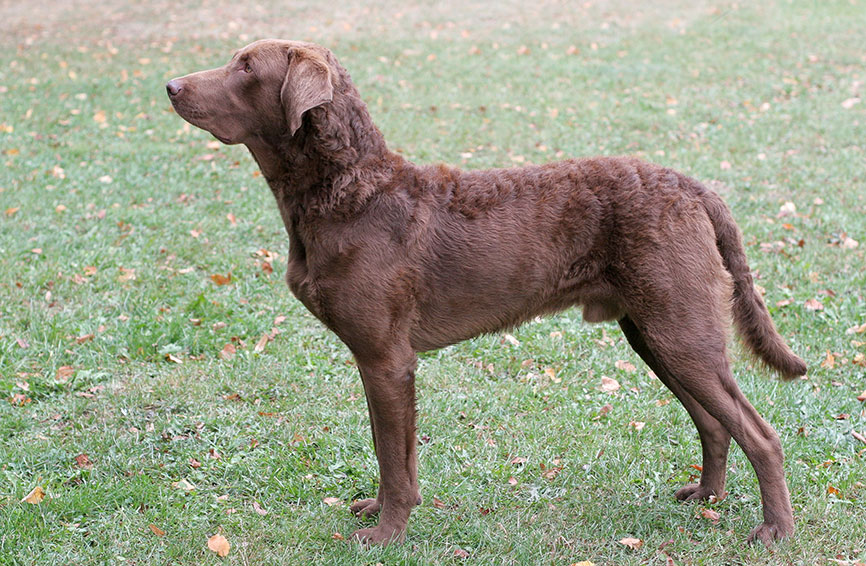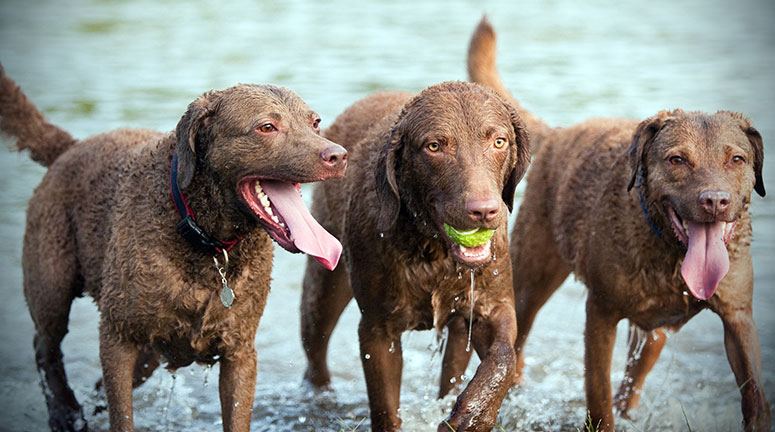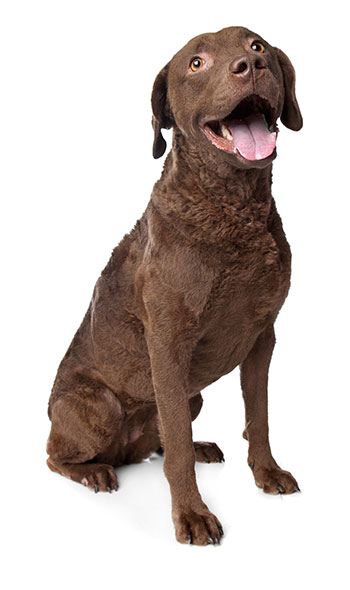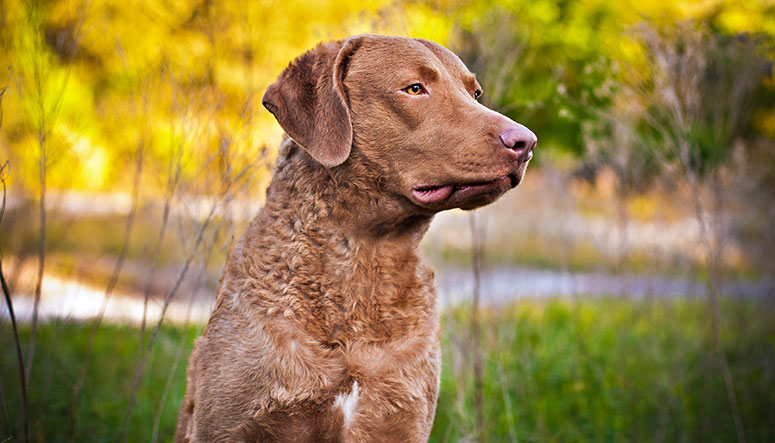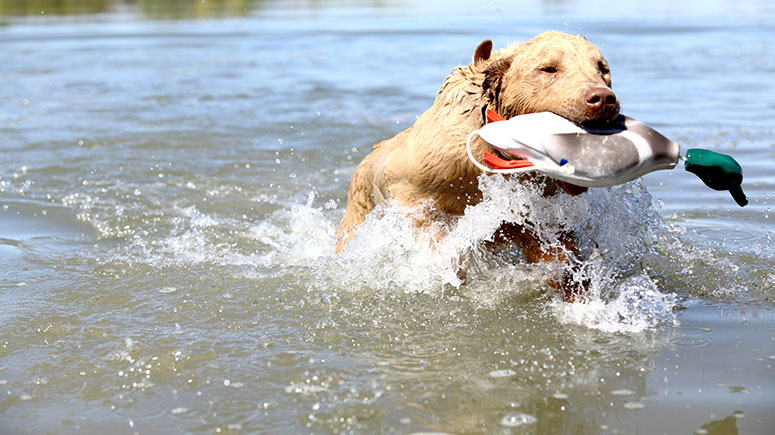Table of Contents
Introduction to Chesapeake Bay Retrievers
Chesapeake Bay retrievers are smart, affectionate, and loving dogs with a medium size and endless loyalty. This is a dog that enjoys having a job to do, and as the name suggests, they love both land and water. The breed was originally used to retrieve ducks in the Chesapeake Bay of Maryland, and they are also excellent hunting dogs. But today, most Chesapeake Bay retrievers are beloved family dogs that do very well with active families that love getting outside and exploring nature.
Could a Chesapeake Bay retriever be the perfect addition to your life and your ideal furry companion? Read on to learn more about this breed and tips for taking the best care of a Chesapeake Bay retriever’s health.
Size of Chesapeake Bay Retrievers
Chesapeake Bay retrievers are medium-sized dogs that are very friendly and get along with pretty much everyone. Adult males weigh about 65 to 80 pounds, and adult females weight about 55 to 70 pounds. For height, males grow to be around 23 to 26 inches tall, and females are 21 to 24 inches tall.
Dogs of this breed stop growing usually between 12 months and 18 months of age. Below is a chart describing how big you can expect your Chesapeake Bay retriever to get as the dog grows from puppyhood to adulthood. Male dogs are on the high end of the weight range, while female dogs are on the low end of the range.
| Weight Chart | 3 months | 7 months | 9 months | 12 months |
| Female and Male Chesapeake Bay Retrievers | 20-26 lbs. | 40-60 lbs. | 48-68 lbs. | 55-77 lbs. |
Characteristics of Chesapeake Bay Retrievers
Chesapeake Bay retrievers are moderately adaptable dogs that need space to move around, are affectionate with family, and typically shed a good amount. These dogs need a lot of exercise and love to go swimming. If not properly exercised, they can get bored and show destructive behaviors.
Some things to know about Chesapeake Bay retrievers are that they can be territorial and aggressive towards other pets and people. They must be socialized from an early age and it may be best for a Chesapeake Bay retriever to be the only pet in the house. They aren’t the best dogs for first-time pet-parents, but people who are experienced with dogs will love the versatility of the breed and have lots of fun exploring the outdoors together.
As you get to know a Chesapeake Bay Retriever’s personality, here’s what you can expect based on his or her breed characteristics:
| Breed Characteristic | Level (High, Medium, Low) |
| Affectionate with People | Medium |
| Good with Kids | Medium |
| Good with Pets | Low |
| Need for Exercise | High |
| Energy Level | High |
| Intelligence Level | Medium |
| Able to Be Trained | Medium |
| Amount of Barking | Medium |
| Amount of Shedding | High |
History of Chesapeake Bay Retrievers
The history of this dog breed dates back to the 19th century, when wealthy duck club owners developed the breed for their duck-hunting purposes. This took place around the Chesapeake Bay of Maryland, which is a 200-mile estuary that is fairly shallow and has freezing temperatures during the winter until early spring. Historians believe the genetic origins of the Chesapeake Bay retriever are linked to Newfoundlands, Irish water spaniels, and hounds. Records suggest that the breed descended from two Newfoundland dogs named Canton and Sailor that traveled on an England-bound ship in 1807.
Sportsmen wanted to use the dogs to hunt ducks in the frigid waters, and they were well-suited to do so because of their thick and oily double coat that is waterproof and insulating. These dogs proved to be able to retrieve hundreds of ducks per day from cold water.
The breed proved itself as a successful retriever, but today, these dogs have much more versatile roles in our society. The dogs have been used for search-and-rescue work, bomb detection, drug sniffing, and therapy jobs. They often excel at athletics competitions and dog shows because of their strength and attractiveness. The American Kennel Club recognized the breed in 1884, and the American Chesapeake Club formed in 1918.
Chesapeake Bay Retriever Standard Information
In general, Chesapeake Bay retrievers are hearty, athletic, and well-suited for swimming in icy waters. They have jaws that can carry large game birds, a double coat to protect them from the cold, and a powerful build that is impressive in the canine world. Otherwise, the dogs have a happy disposition, are intelligent, and affectionate and protective when around family members.
Here is an overview of the breed standard information for Chesapeake Bay retrievers:
Head:
- Intelligent expression
- Eyes medium-large, yellowish or amber color, set wide apart
- Muzzle about the same length as skull
- Scissors bite is preferred
- Ears small and set up well on head
Neck, Topline, Body:
- Neck of medium length, strong, and muscular
- Back is short, powerful, and well-coupled
- Strong, wide, and deep chest
Forequarters:
- Shoulders sloping with plenty of power
- Pasterns slightly bent and medium length
- Dewclaws may be removed on forelegs
- Well-webbed hare feet
Hindquarters:
- Powerful hindquarters for swimming
- Legs of medium length and straight
- Stifles well angulated
- Dewclaws must be removed from hind legs
Coat:
- Short and not over 1 ½ inches long anywhere
- Oil in the harsh outer coat and wooly undercoat
- Resists water in the same way a duck’s feathers do
Color:
- Brown, sedge, or deadgrass colors
- No color is preferred over another
- White spot on the belly, breast, toes, or back of feet is permissible
Gait:
- Smooth, free, and effortless
- Good reach with no restrictions of movement
- No sign of cowhockness from the rear
Caring for Chesapeake Bay Retrievers
Although a Chesapeake Bay retriever can live in an apartment, the dog will be much happier in a home with a yard to run around in. These dogs need to be walked at least twice per day and really benefit from a good amount of daily exercise. They prefer cool climates but can do okay in warm weather if given opportunities to swim in water and cool off. Chesapeake Bay retrievers are generally better dogs for the country or suburbs, rather than city dogs.
Here are some general tips for taking the best care of a Chesapeake Bay retriever:
Best Living Environments:
- Home with a yard
- Property with access to safe swimming water
- Breed does better with children over age 8 than younger children
- Not the best breed with other pets but can do okay with dogs and cats if socialized early
Type of Exercise:
- Swimming in natural bodies of water or pools
- Games of fetch in a yard
- Neighborhood walks
- Jogs of a mile or less, while taking breaks periodically until strength is built up
Mental Enrichment:
- Chasing a ball or frisbee
- Activities in and around water
- Relaxing time on the sofa with family members
Training Strategies:
- Independent dogs that have a mind of their own
- Use consistency and kindness when training
- Positive reinforcement with food rewards and praise
- Can be stubborn during training
Grooming Tips:
- Prone to heavy shedding
- Brush weekly with a rubber brush
- Bathe as little as possible to preserve oils in the coat
- A bath or two during shedding season can help new hair grow in, however
Common Health Problems of Chesapeake Bay Retrievers
The average life span of a Chesapeake Bay retriever is 10 to 13 years. The national breed club for this dog recommends the following heath tests: hip evaluation, progressive retinal atrophy/progressive rod-cone degeneration (PRA-prcd) DNA test, elbow evaluation, degenerative myelopathy DNA test, exercise induced collapse DNA test, and ophthalmologist evaluation.
These are some of the most common health issues that arise with Chesapeake Bay retrievers:
- Hip dysplasia
- Elbow dysplasia
- Chondrodysplasia
- Degenerative myelopathy
- Progressive retinal atrophy
- Cataracts
- Von Willebrand’s disease
- Gastric dilation-volvulus (bloat)
- Exercise-induced collapse
- Epilepsy
Diet and Nutrition for Chesapeake Bay Retrievers
As a medium-sized dog, a Chesapeake Bay retriever needs about 2 to 2 ½ cups of dry dog food per day, divided into two meals. Feed a high-quality quiet and measure out your dog’s food, according to the label recommendations. These dogs are prone to gaining weight, so you will need to watch their food intake and level of exercise to maintain a healthy pup.
Where to Adopt or Purchase Chesapeake Bay Retrievers
If you are interested in bringing a Chesapeake Bay retriever into your life, there are numerous resources available for adopting a rescue dog or purchasing a purebred dog. Here are some options to look into:
- AKC Marketplace
- American Chesapeake Club
- Chesapeake Bay Retriever Relief & Rescue
- North Central Chesapeake Bay Retriever Relief and Rescue
- Chesapeake Safe Harbor
Related Breeds
The Chesapeake Bay retriever is a retriever-type dog, and it that it shares characteristics with other breeds in terms of personality, temperament, abilities, and appearance. Here are some similar and related breeds to the Chesapeake Bay retriever:
- Boerboel
- Dalmatian
- Hovawart
- German wirehaired pointer
- German pinscher
- Karelian bear dog
- Golden retriever
- Labrador retriever
Pet Insurance for Chesapeake Bay Retrievers
Since Chesapeake Bay retrievers are active and adventurous dogs, it is best to be prepared for potential accidents and illnesses before they happen. Healthy Paws offers Chesapeake Bay retriever insurance with one easy-to-understand policy, no costly add-ons, and the ability to use any licensed veterinarian you choose.
Get an instant quote now and take the first step to protect your Chesapeake Bay retriever for many healthy years ahead.
